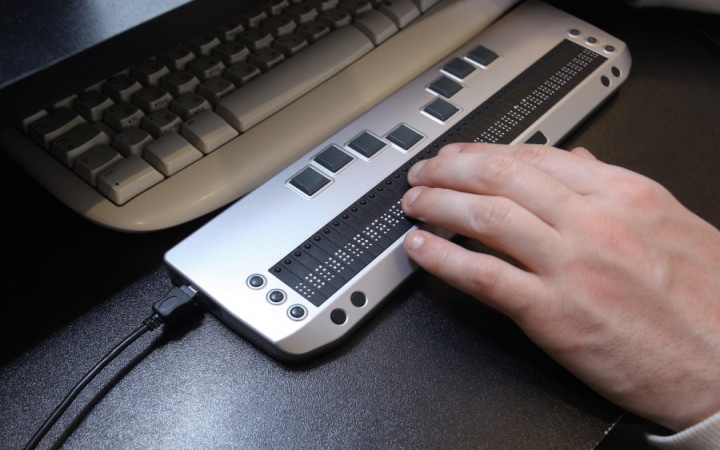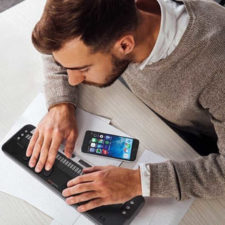Discover Ingenious Devices Created for the Visually Damaged
The development of cutting-edge devices for the aesthetically impaired stands for a considerable development in access and self-reliance. Technologies such as smart glasses with AI abilities and mobile applications designed to give auditory summaries are improving daily experiences for customers. Additionally, wearable gadgets that employ haptic comments boost environmental awareness, while contemporary Braille innovations offer new methods to involve with message. As these devices proceed to develop, their effect on the lives of those with aesthetic problems raises essential concerns regarding the future of inclusivity and autonomy in various elements of life. What exists in advance in this technological landscape?
Smart Glasses for Navigation

Smart glasses developed for navigation are changing the means visually impaired individuals connect with their setting. These innovative tools utilize a combination of video camera innovation, fabricated knowledge, and acoustic feedback to provide real-time information about surroundings. By employing obstacle detection systems, smart glasses can notify individuals to prospective dangers, making it possible for more secure flexibility in both strange and acquainted setups.
The assimilation of GPS innovation additionally improves navigating abilities, enabling individuals to receive auditory directions as they relocate. This hands-free strategy not just promotes self-reliance however likewise equips visually impaired individuals to browse city landscapes with increased self-confidence. In addition, many smart glasses are equipped with features that recognize spots and road indicators, giving contextual details that boosts the individual experience.
Moreover, the growth of these tools is continually advancing, with business functioning to boost the precision of item recognition and expand the series of navigational functions. As smart glasses come to be a lot more available and affordable, they hold the prospective to significantly change every day life for aesthetically impaired customers. Ultimately, these cutting-edge tools stand for an important step towards inclusivity, offering boosted mobility and a higher feeling of freedom for people navigating the globe around them.

Mobile Apps for Daily Living
Exactly how can mobile applications enhance the daily lives of aesthetically damaged individuals? Mobile apps are changing the means visually impaired customers browse their atmospheres, handle everyday tasks, and access details. These applications give essential support via numerous capabilities, cultivating self-reliance and enhancing lifestyle.
Numerous cutting-edge mobile apps are developed particularly for day-to-day living. For example, applications like Be My Eyes link visually impaired individuals with sighted volunteers by means of video calls, allowing them to receive real-time aid with tasks such as reading tags or navigating strange rooms. Likewise, Seeing AI, developed by Microsoft, makes use of expert system to describe environments, checked out text, and recognize objects, properly transforming a mobile phone right into a powerful device for day-to-day support.
In addition, navigating apps customized for the visually damaged, such as Aira and BlindSquare, use audio-based directions and environmental info, making it possible for customers to traverse their environments safely and confidently. Beyond navigation and instant help, mobile applications additionally support organization and task administration, with functions that help customers establish reminders, create to-do listings, and track visits. In recap, mobile applications offer as indispensable resources, empowering visually impaired people to lead even more independent and meeting lives.
Wearable Technologies for Aid
Empowerment with innovation is progressively obvious in the world of wearable gadgets created to help visually impaired individuals. These cutting-edge devices incorporate flawlessly into life, boosting navigating and supplying crucial responses to individuals. Wise glasses equipped with video cameras can read and identify faces text out loud, permitting individuals to interact even more confidently in expert and social settings.
An additional significant development is making use of haptic responses systems in wearable devices. These systems make use of vibrations or various other tactile signals to convey details regarding the customer's atmosphere, such as obstacles or modifications in terrain, enhancing mobility and safety and security. Wearable innovations additionally consist of wristbands that connect to mobile phones, notifying users to notices with refined vibrations, thus improving connection without dependence on aesthetic cues.
As these technologies remain to develop, they are not just enhancing freedom for aesthetically impaired people but likewise cultivating a greater feeling of inclusion in culture. By linking the gap between obstacles faced in daily living and the capacity for freedom, wearable technologies work as crucial devices in the quest for equality and empowerment for those with aesthetic impairments.
Audio Summary Devices
Sound description tools play a crucial function in improving accessibility for visually impaired people, providing them with the capability to engage with aesthetic media. Voice-activated assistive devices. These devices supply narrated summaries of vital aesthetic components in movies, tv programs, and live efficiencies, making certain that users can completely comprehend the context and emotions communicated with visuals
Audio description can be integrated into different platforms, including streaming services, movie theater testings, and live cinema. Several preferred streaming solutions currently consist of audio description as an access attribute, permitting visitors to select it easily. Along with mainstream media, specialized applications additionally exist, supplying audio summaries for art exhibits, galleries, and other cultural events.
The effectiveness of audio summary depends upon the ability of the storytellers, that need to communicate visual information succinctly without interfering with the original audio. Developments in this field are additionally leading the way for even more tailored experiences, where individuals can adjust the degree of detail and pacing according to their preferences.
Braille Innovations and Instruments
Braille technologies and gadgets have actually significantly transformed the method visually impaired people communicate with text and information. Modern innovations have actually resulted in the advancement of versatile devices that boost proficiency and self-reliance amongst customers. Especially, Braille display modern technologies have actually advanced, permitting vibrant analysis experiences. These gadgets transform electronic message into Braille, enabling users to access a substantial variety of info on computer systems, tablets, and smart devices.
In addition, mobile Braille notetakers combine conventional Braille input with contemporary functionalities, helping with note-taking, organizing, and record modifying on the go. Screen readers for the blind. These portable tools commonly feature text-to-speech abilities, connecting the space in between Braille and acoustic information
On top of that, innovative Braille printers have emerged, permitting users to produce Braille labels, files, and instructional materials effectively. This access promotes better involvement in educational and expert settings, eventually promoting inclusivity.
Furthermore, research study right into smart Braille technologies remains to increase. Tools that integrate expert system are being discovered to offer real-time navigating aid and contextual info, improving the customer experience in diverse settings. Overall, these advancements reflect a dedication to encouraging visually damaged individuals with modern technology, ensuring they can quickly gain access to and engage with the world around them.

Final Thought
The development of cutting-edge tools for the visually damaged significantly improves freedom and high quality of life. Voice-activated assistive devices These modern technologies not just foster greater addition however likewise promote freedom in day-to-day activities, ultimately contributing to a more accessible and fair society for visually damaged individuals.
As wise glasses end up being more obtainable and inexpensive, they hold the potential to substantially transform day-to-day life for visually damaged customers. Mobile applications are reinventing the means visually damaged users navigate their atmospheres, handle daily jobs, and gain access to info. Apps like Be My Eyes link visually damaged customers with sighted volunteers via video clip phone calls, permitting them to get real-time help with jobs such as checking out tags or navigating strange rooms.Additionally, navigation apps customized for the aesthetically damaged, such as Aira and BlindSquare, supply audio-based directions and environmental information, enabling individuals to traverse their surroundings securely and confidently.The improvement of innovative devices for the visually impaired substantially enhances self-reliance and top quality of life.